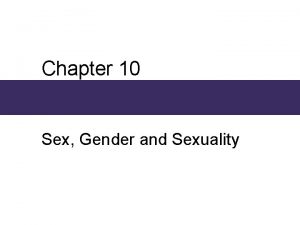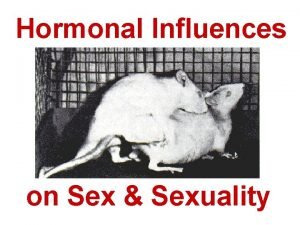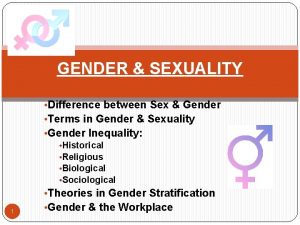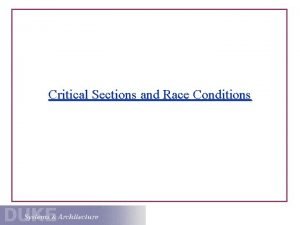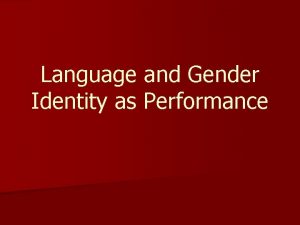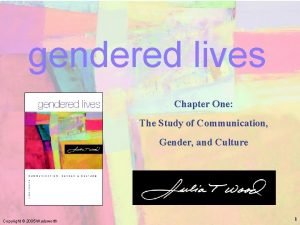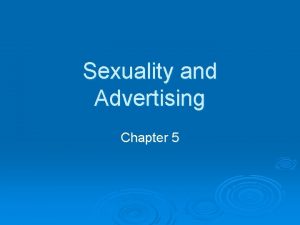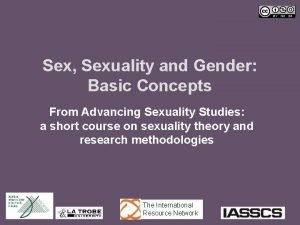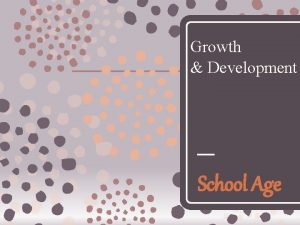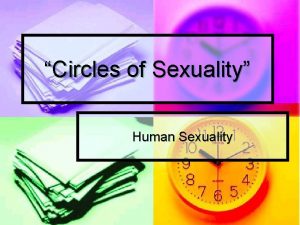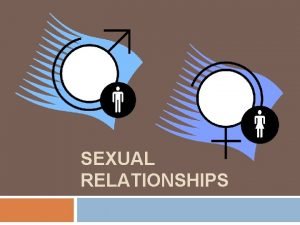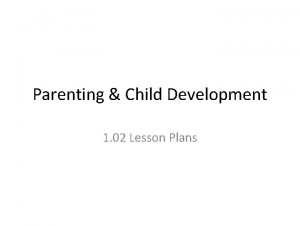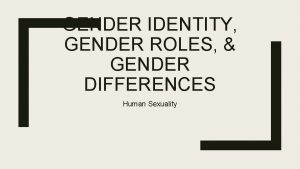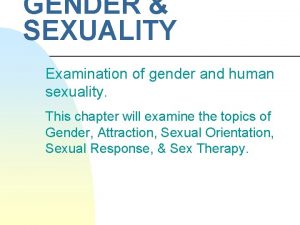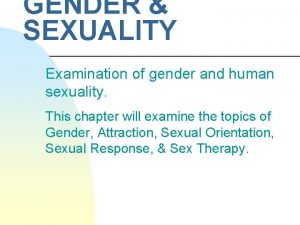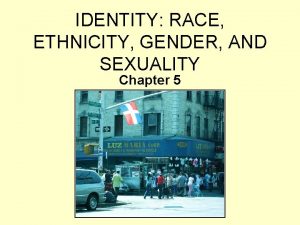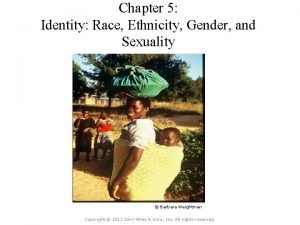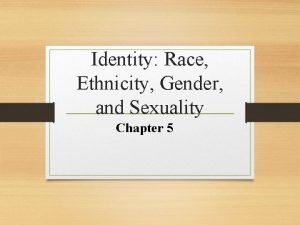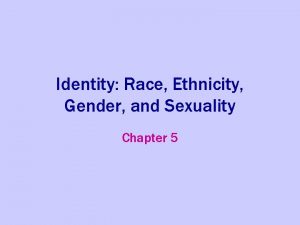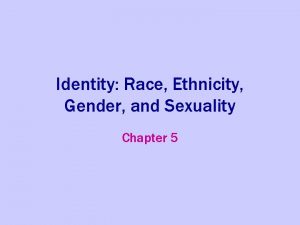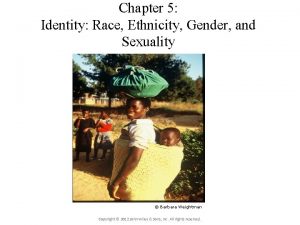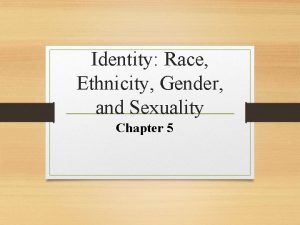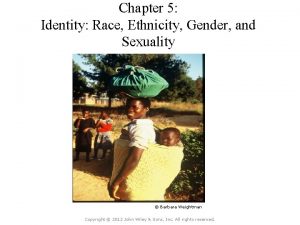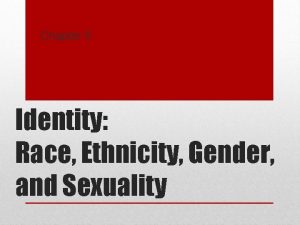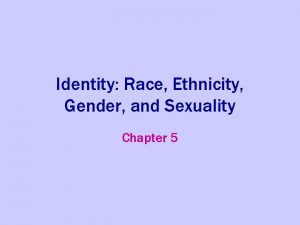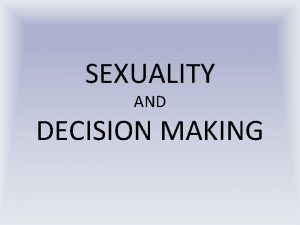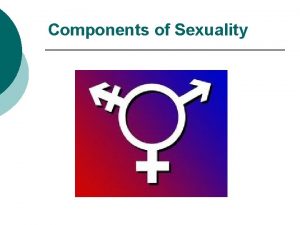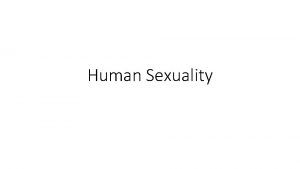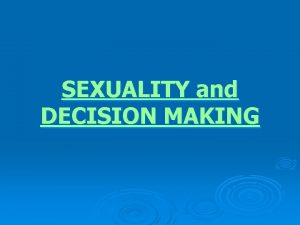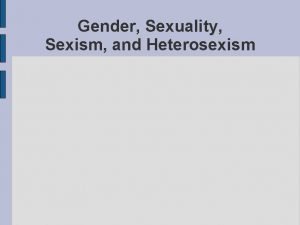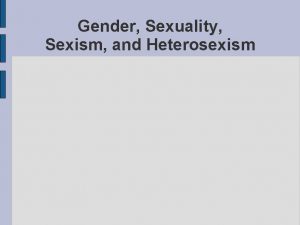Identity Race Culture Gender Sexuality Review Ch 5





















- Slides: 21

Identity: Race, Culture, Gender, & Sexuality Review Ch. 5


Identity Big Ideas Identity Ethnicity Distribution Ethnic Islands, Ethnic neighborhoods, Ethnic Conflict, & Enclaves Race Segregation Gendered Power Space Relationships Sexuality

Identity How We construct our own identities Vary Are we make sense of ourselves across scales, & affect others across scales. fluid, constantly changing, shifting, & becoming We work towards an identity that meshes with who and where we are at any given point in time. We also define others Identifying against – we define the “other” and define ourselves as “not the other”

What is Ethnicity? Often confused with culture Includes Based A culture, but also encompasses many other ideas on how people choose to identify themselves social group that defines itself based on factors such as common culture traits or a common history, race, or geographic region.

Ethnicity Groups define what constitutes membership Several theories exist why humans organize themselves into ethnic groups. Some believe people are born with an instinctive sense of ethnic identity. Pervasiveness of ethnocentrism – attitude of cultural superiority Ethnicity is socially constructed. Ethnic identity is a result of the interaction among different groups of people.

Ethnic Neighborhoods At the smallest geographic scale, we can identify ethnic neighborhoods in many towns and cities. Areas with concentrated populations of a particular ethnic group Can change their ethnic identity over time Ethnic groups can be locked into a distinct geographic area Historically, European Jews were restricted to certain areas – ghettos Reflected the mistrust & ethnic hatred, but can provide a degree of protection Spatial reasons for segregation New laws can be passed Segregated groups can choose to live together rather than assimilating or moving

Ethnic distribution - US – every 10 years, Census conducts an enumeration of the population Survey identifies three main ethnicities Asian Americans – from countries in Asia African Americans – identify as a group with Hispanic – from Spanish-speaking countries Ethnic cultural origins in Africa groups may live in different regions and particular communities Hispanics – clustered in Southwest African-Americans Asian – clustered in Southeast Americans – clustered in the West


Ethnic Neighborhoods African American & Hispanic are highly clustered in urban areas I. E. Chicago – neighborhoods in the south and west side have extensive African American clusters I. E. Los Angeles – African Americans in south-central; Hispanics in east; Asian Americans in south and west.

Ethnic Islands Larger than ethnic neighborhoods or ethnoburbs Ares of ethnic concentration in rural, or non-urban areas Settled after the mid-19 th century (US & Canada) Cluster migration – the settlement of a whole area en masse by a particular ethnic group Chain migration also assisted in creation of ethnic islands.

Ethnic conflict - competition Ethnicity and nationality are similar concepts in that membership is defined through shared cultural values Nationality differs from ethnicity in terms of legal standing. Defined specifically through shared experiences derived from voting, obtaining a passport, and performing civic duties. Confusion between the two can lead to violent conflicts Lebanon – 60% Muslim & 40% Christians consider themselves ethnically descended from the Ancient Phoenicians. When government system was created Christians controlled a majority. Sri Lanka – 3 principal ethnicities (Sinhalese, Tamil, and Moors) dispute between Sinhalese and Tamil date back more than 2000 years. Tamil feel discriminated against by Sinhalese.

Ethnic conflict - division South Asia Pakistan & India – basis of separation was ethnicity India majority Hindu Pakistan majority Muslim Kurds Live in the Caucasus Mountains After WWI, created an independent state of Kurdistan 1923 – became part of Turkey Today, the Kurds are split among several countries Turkey has tried repeatedly to suppress the Kurdish culture, including outlawing their language.

Ethnic Conflict – Cleansing & Genocide Ethnic cleansing – process where a more powerful ethnic group forcibly removes a less powerful one to create ethnically homogeneous region Removal of all members of less powerful ethnicity – men & women, young & old. In recent years , carried out primarily in Europe and Africa Nazi Europe – deportation of Jews, Gypsies, & other undesirable groups Bosnia (1993) – ethnic cleansing of the Bosnian Muslims Serb & Croats fought to reunite the portions that they inhabited with Serbia and Croatia, respectively. Kosovo Part (late 1990 s) of Serbia, with ethnic Albanians compromised 90% of the population Serbs launched a 4 part campaign of ethnic cleansing By 1999, had forced 750, 000 pf the 2 million Albanians from their homes.

Ethnic Conflict – Cleansing & Genocide (continued) Widespread in Africa because of the colonial boundaries. Northeastern Arab Africa – Sudan nomads (Janjaweed) crushed Darfur’s black population 480, 000 killed; 2. 8 million forced to live in refugee camps Somalia Several Rwanda Congo different ethnic groups vying for control (1994) – Hutus vs. Tutsi (late 1990 s) – Hutus & Mayi vs. Tutsi

Race A categorization of humans based on skin color & other physical characteristics Categories are social & political constructions because they are based on ideas that some biological differences are more important than others An identity that is often assigned.

Segregation Residential segregation Historically states, cities, & towns passed laws outlining residential segregation Disallowing the migration of certain racial groups into neighborhoods. Douglas Massey & Nancy Denton – defined as a degree to which two or more groups live separately from one another, in different parts of the urban environment. Most residentially segregated large metropolitan area for African Americans is Milwaukee Wisconsin Second, Least Detroit Michigan segregated area is Orange County, California; followed by San Jose, California.

Gender Refers to the societal norms and behaviors that are expected of males or females. Geographers have increasingly looked at gender as a source of identity. Believe that society shapes spaces based on socially defined gender roles & that gender affects the way we interact with the world. Gendered Gender – places designed for women or for men. roles are not the same in all countries.

Power Relationships Assumptions and structures about who is in control, who has power over others. Affect Can identities directly and cultural landscapes also subjugate entire groups of people. Society Women enforces ideas about the ways people should behave in Sub-Saharan Africa Populate Society Have much of the rural areas. and governments work in conjunction to subjugate women heavy responsibilities and few rights. Produce estimate 70% of the regions food

India – Dowry Deaths Murders of brides (often by burning) when a dispute arises over dowry Difficult to “legislate away” the power relationships that lead to dowry deaths Women still remain disempowered in much of Indian societies Female infanticide is also tied to the disempowerment of women. Rescaling issues to the global scale has the potential to draw attention to the social ills.

Sexuality Cultures decide what is “normal” sexually Glen Elder, Lawrence Knopp, Heidi Nast – argue that most social science is written in a heteronormative way The default subject in the minds of the academics who write studies is heterosexual, white, & male. Initial forays focused largely on where people with shared “identity” cluster. Today, focusing not only on the distribution but also on theories behind the experiences, that explain and inform our understanding of sexuality and space. Employ queer theory Theory that “highlights the contextual nature of opposition to the heteronormative and focuses on the political engagement of “queers” with the heteronormative”
 Chapter 10 sex gender and sexuality
Chapter 10 sex gender and sexuality Androgen insensitivity syndrome
Androgen insensitivity syndrome What is talcott parsons structural functionalism
What is talcott parsons structural functionalism Data race vs race condition
Data race vs race condition Head race and tail race
Head race and tail race Function of spillway
Function of spillway Strategic gender needs and practical gender needs
Strategic gender needs and practical gender needs Development of gender roles
Development of gender roles Sexual orientation gender identity
Sexual orientation gender identity Gender identity
Gender identity Gender identity tagalog
Gender identity tagalog What is the study of communication, gender and culture
What is the study of communication, gender and culture Sexuality in advertising
Sexuality in advertising Four intertwining strands of sexuality
Four intertwining strands of sexuality Pretest: growth, development, and sexuality
Pretest: growth, development, and sexuality Awareness, acceptance and comfort with one’s own body.
Awareness, acceptance and comfort with one’s own body. Definition of sexuality
Definition of sexuality Types of sexual relationships
Types of sexual relationships Which illustrates an emotional aspect of teen sexuality?
Which illustrates an emotional aspect of teen sexuality? Peer sexuality support programme
Peer sexuality support programme Sexuality
Sexuality Sexuality spectrum
Sexuality spectrum
